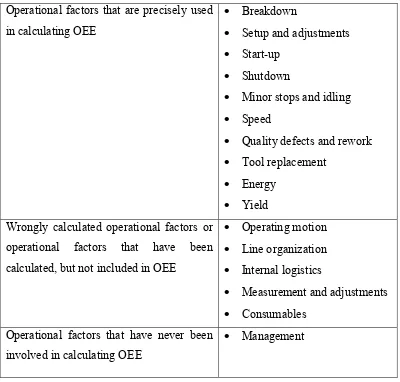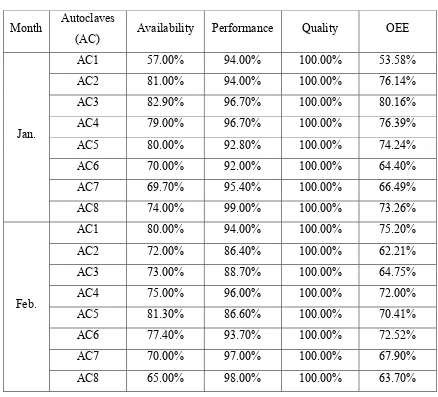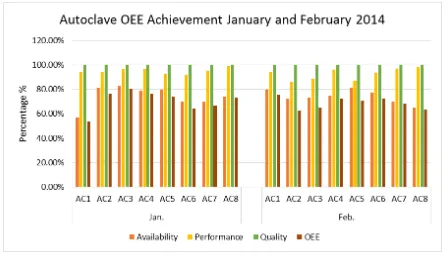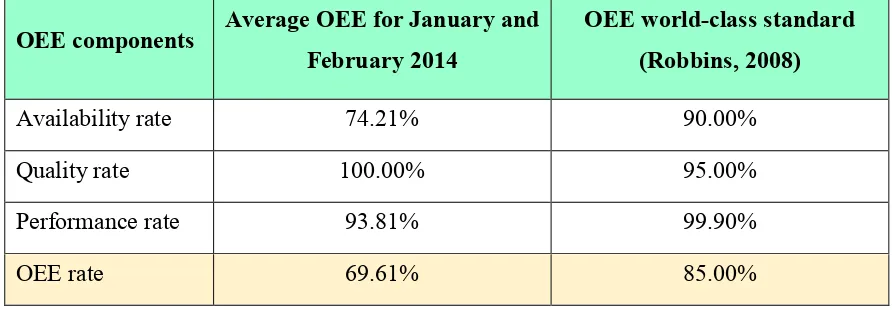UNIVERSITI TEKNIKAL MALAYSIA MELAKA
A FRAMEWORK TO IDENTIFY OPERATIONAL FACTORS IN
OVERALL EQUIPMENT EFFECTIVENESS (OEE) TOWARDS
LEAN MANUFACTURING
This report submitted in accordance with requirement of the Universiti Teknikal Malaysia Melaka (UTeM) for the Bachelor Degree of Manufacturing Engineering
(Manufacturing Management) (Hons.)
by
NUR HALIMAH BINTI JAMALULIL B051110063
921011-01-6478
ABSTRACT
ABSTRAK
DEDICATION
ACKNOWLEDGEMENT
I would like to thank the management of company who gives me the opportunity in applying the knowledge learned and concept proposed in the production line of Autoclave curing section. Without the information and data from the company, the study could not be carried out smoothly and might be lacking in a few aspects. The information and data provided by the company encouraged my pursuit to achieve the aim of the study, and further to reach the results and conclusion of the study.
Besides that, I was in contact with many people from the company during which the implementation of the OEE. Among them include Mr. Abdul Rahman who gives support and endless effort to help out in carrying out my study. He has been aiding me in acquiring resources, which includes cooperation from man power, assessment to time data and many others. Not forgetting the other engineers and operators who are responsible on Autoclave section and my understanding regarding the Autoclave operation, which includes the process flow, characteristics and nature of manufacturing environment of the production. All of them deserve special thanks because the study will be barely accomplished without their kind assistance.
LIST OF TABLES
TABLES TITLE
PAGE
1.2 (a) Operational factors that involved in calculating OEE of
Autoclaves in an aero-composite company 6
1.2 (b) Overall OEE rate in January and February 2014 7 1.2 (c) Comparison between company data and world-class standard 9
2.10 (a) OEE calculation 29
2.10 (b) Summary of the various OEE implementation 35
4.1 Details of operational factors 49
4.2 Availability rate of Autoclave 1 – 9 in January and February 54 4.3 Performance rate of Autoclave 1 – 9 in January and February 59
4.4 The calculation of quality rate 62
4.5 (a) Average OEE values for 9 Autoclaves 64
LIST OF FIGURES
FIGURES TITLE PAGE
1.2 (a) Operational factors in OEE calculations of Autoclaves 5
1.2 (b) OEE rate in January and February 2014 8
2.4 The six big losses (Huffman, 2014) 15
2.6 16 major losses in TPM (JMAC, 2013) 17
2.10 (a) Continuous product line, manufacturing system (Nachiappan &
Anantharaman, 2006) 26
2.10 (b) Calculation of OLE (for continuous product line
manufacturing system) (Nachiappan & Anantharaman, 2006) 27 2.10 (c) Major components of losses in the oilfields 30
2.10 (d) The OEE workover activities 33
2.10 (e) Complete OEE’ s compound for four rigs 33
3.1 Overall methodology of study 38
3.2 Procedure in reviewing literature 40
3.4 Flowchart of evaluating the OEE calculation methods 44
3.5 Framework of optimizing the OEE calculations with
operational factors 46
4.2 (a) The downtime configuration for each Autoclave in hourly
unit (January) 52
4.2 (b) The downtime configuration for each Autoclave in hourly
unit (February) 53
4.2 (c) Percentage of improvement in availability rate 56
4.3 (a) Total cycle time of Autoclaves 58
4.3 (b) Percentage of improvement in performance rate 60
LIST OF ABBREVIATI ONS
OEE - Overall Equipment Effectiveness TPM - Total Productive Maintenance
AC - Autoclave
WCM - World Class Manufacturing
C/T - Cycle time
OLE - Overall Line Effectiveness
LA - Line availability
LP - Performance efficiency of the flow line LQ - Quality efficiency of the flow line
OT - Operating time
CT - Calendar time
LPQP - Line production quality performance efficiency CNC - Computer Numerical Control
ESP - Electrical submersible pumps TWT - Total workover time
BTWT - Best time achieved
RIH - Run in hole with downhole equipment
TABLE OF CONTENT
PAGE
ABSTRACT i
ABSTRAK ii
DEDICATION iii
ACKNOWLEDGEMENT iv
LIST OF TABLES v
LIST OF FIGURES vi
LIST OF ABBREVIATIONS viii
CHAPTER 1 : INTRODUCTION 1
1.1 Background 1
1.1.1 Background of OEE concept with operational factors 1
1.1.2 Background of subject of study 3
1.2 Problem statement 4
1.3 Objectives 9
1.4 Significance of the study 10
CHAPTER 2 : LITERATURE REVIEW 12
2.1 Overview of OEE 12
2.2 Objectives of OEE 13
2.3 Implementation of OEE 13
2.4 The six big losses 14
2.5 Components of OEE 15
2.6 16 major losses in TPM 17
2.7 Operational factors 18
2.8 Performance of OEE 21
2.9 Effectiveness of OEE 22
2.10 OEE calculation methods 23
2.10.1 Quantitative calculation procedure model 23
2.10.2 Overall line effectiveness (OLE) 25
2.10.3 OEE in shipbuilding field 28
2.10.4 Calibration of OEE 30
2.11 Conclusion 36
CHAPTER 3 : METHODOLOGY 37
3.1 Overall procedures of the study 37
3.2 Procedure in reviewing literature 40
3.5 Development of the framework 45
3.6 Summary 47
CHAPTER 4 : RESULTS AND DISCUSSION 48
4.1 Implementation of framework 48
4.2 Availability rate 51
4.2.1 Downtime of Autoclaves 52
4.2.2 Availability rate calculation 54
4.2.3 Percentage of improvement in availability rate 55
4.3 Performance rate 57
4.3.1 Cycle time of Autoclaves 57
4.3.2 Performance rate calculation 58
4.3.3 Percentage of improvement in performance rate 59
4.4 Quality rate 61
4.4.1 Quality rate calculation 61
4.4.2 Percentage of improvement in quality rate 63
4.5 Overall equipment effectiveness (OEE) rate 64
CHAPTER 5 : CONCLUSION 66
5.1 Conclusion 66
REFERENCES 69
CHAPTER 1
INTRODUCTION
This chapter basically introduces the causes and the existing problems which initiate this study. It is also including the background of the study and the focused objectives. By the end of the chapter, the project scope will be clarified to set the boundary of the study where it should lie within.
1.1 Background
This section consists of two subsections. The first subsection is the background involving the relation between the operational factors and the concept of overall equipment effectiveness (OEE). A brief introduction and explanation are included in this subsection. The second portion of this segment is the background of the field of work. The introduction of Autoclaves and curing process are included in the second subsection. The selection of Autoclaves and the data required are also included in this part.
1.1.1 Background of OEE concept with operational factors
products, certainly should be eliminated. The enticing productivity, cost, inventory, quality and delivery all depend on the adequate operation of the company’s equipment (Hemant and Pratesh, 2012). In order to eliminate the existing wastes, many tools and techniques in Lean Manufacturing can be applied. One of the Lean Manufacturing tools and techniques is the application of overall equipment effectiveness (OEE) in industries. The OEE is important and have been vastly used as metrics of performance in the manufacturing area, particularly for companies that applied total productive maintenance (TPM) (Wudhikarn, 2012).
OEE is a way to monitor and improve the efficiency of the manufacturing process. OEE has become an accepted management tool to measure and evaluate plant floor, machines and equipment productivity. OEE is a valuable tool that can help to unleash hidden capacity and therefore reduce overtime expenditures and allow deferral of major capital investment. It helps to reduce process variability, reducing changeover times and improving operator performance. OEE empowers manufacturing companies to improve processes and in turn ensure quality, consistency, and productivity measured at the bottom line.
OEE measures the percentage of number of a product or part produced without defects versus the capacity of product or part that could be generated according to the equipment’s design. A machine or process that has an OEE of 100% is generated at its maximum designed capacity with zero defects (Mohamed Hamed Ahmad, 2013). According to Huffman (2014), OEE is a measurement tool leading to a perfect production; where OEE score is set to 100%, where it takes into account of all losses (downtime losses, speed losses, and quality losses). But as it is almost impossible to achieve the perfect production, the OEE world-class rate of 85% is the best score to be set as a benchmark in Lean Manufacturing (Fast, 2011).
be able to contribute in achieving the OEE percentage rate, at best towards the OEE world-class standard percentage rate at 85%. Each of the OEE components is influenced by some operational factors related to the 6 major losses in industries. This leads to OEE percentage rate are also affected by operational factors, whether towards improvement or failure of OEE implementation. However, there are more of the operational factors that usually are lacking in the OEE calculation that affect the OEE percentage rate. Each of the operational factors need to be included in the appropriate OEE components in order to determine the ideal OEE percentage rate that is comparable to the world-class standard. Therefore, operational factors play an important role to determine the OEE to create the Lean Manufacturing environment.
1.1.2 Background on the subject of study
The study is carried out in an aero-composite company. The company is applying OEE in most of the machines and equipment involved in the production. However, this study shall be focusing on the Autoclaves only, in which several of the machines are comprising a manufacturing section in the company. The Autoclave is used to harden the ply materials from the lay-up process. Lay-up process as the supplier process of Autoclave curing process, is actually to stack up one ply onto another in the amount and at the orientation as per the design of aerospace parts. The ply materials after being cured by autoclave will become harden aeroplane parts for assembly of different area in different aeroplane model. Autoclave curing process is a critical process in the production because the parts that encountered defects due to the curing process cannot be reworked. This is where the wastes occurred in the production and needed to be eliminated.
with the consideration of a few operational factors. In this study, nonetheless, will only be focusing on two of the worst Autoclaves operated out of all 8 Autoclaves. Improvements can be made for these two Autoclaves in terms of their OEE rate, which can further contribute in the production.
The OEE data that are used for this study is based on the past record of the Autoclaves’ operation. For the record, the OEE calculation methods that are used to attain the OEE percentage rate will be evaluated in order to determine the operational factors included in the OEE calculation. The OEE calculation methods used in the company will be compared to the ones used in past studies. When the best method is clarified, it will be implemented in the company to achieve the company target of the OEE rate at 85%, constituting the operational factors that induced in the Autoclaves’ operation.
1.2 Problem statement
Figure 1.2 (a) Operational factors in OEE calculations of Autoclaves
Table 1.2 (a) Operational factors that involved in calculating OEE of Autoclaves in Wrongly calculated operational factors or
operational factors that have been calculated, but not included in OEE
Within the duration of 59 days, there are quite a number of errors detected in the process of determining the OEE rate due to the operational factors are miscalculated or wrongly calculated to cause inaccurate OEE data. The problem further causes fluctuation of OEE calculation for the Autoclaves. The operational factors are yet to be improved for a better OEE result for the Autoclaves’ operations in the company.
performance of OEE is determined based on the company’s recorded data of OEE that had been obtained as shown in Table 1.2 (b).
Table 1.2 (b) Overall OEE rate in January and February 2014
Month Autoclaves
(AC) Availability Performance Quality OEE
Jan.
factors or wrongly calculated of operational factors that involved in the operation, further causing inaccurate OEE data.
Figure 1.2 (b) OEE rate in January and February 2014
Table 1.2(c) Comparison between company data and world-class standard
OEE components Average OEE for January and February 2014
The gap of the percentage rate of OEE between the average OEE for Autoclaves in duration of 59 days and the world-class standard is quite big. Improvement needed to be done in order to increase the OEE rate value of the Autoclaves. With the increment of the OEE rate, subconsciously the performance and effectiveness of the OEE can also be improved. Therefore, the operational factors need to be defined promptly to be included in the OEE calculation in order to obtain the precise OEE rate so that it is comparable to the benchmark rate.
1.3 Objectives
Based on the stated problem, the objectives of this study are defined. With an aim to improve the OEE rate in the case-study company, the objectives of this study are:
i. To determine the operational factors that involve in calculating OEE.
ii. To evaluate the performance and effectiveness of OEE in an aero-composite company.
iii. To develop a new framework for the company usage.
The objectives have been detailed out as follows:
in calculating OEE. From that, the operational factors that have been lacking in calculating OEE or any errors in calculating OEE are able to be detected. Thus, the operational factors that have influenced on the Autoclaves’ operation can be defined clearly and shall be included in the OEE calculation method.
ii. After implementing the best method chosen to calculate OEE, the performance and effectiveness of OEE in Autoclaves operations are monitored to ensure efficiency of the method used. The OEE rate is targeted to increase and exceeding the current OEE rate and is comparable to the OEE rate of the world-class standard.
iii. A framework is designed as a guideline to implement the operational factors in calculating OEE. The operational factors must be correctly identified in the case-study company to achieve a more accurate OEE result. With the aid of the framework, the OEE rate of the company is expected to be improved and is comparable to the OEE of world-class standard.
The objectives of this study are to be accomplished. The objectives are the guidelines for this study to be strategized in order to attain the findings that are sought for this study.
1.4 Significance of the study
1.5 Scope of the study




